Key takeaways:
- Art challenges foster personal growth by pushing artists to explore their creativity within constraints and deadlines.
- Engagement with the art community enriches the experience, providing support and diverse perspectives.
- Preparing for competitions through planning, research, and practice enhances performance and confidence.
- Learning from feedback and stepping outside comfort zones can lead to artistic breakthroughs and resilience.
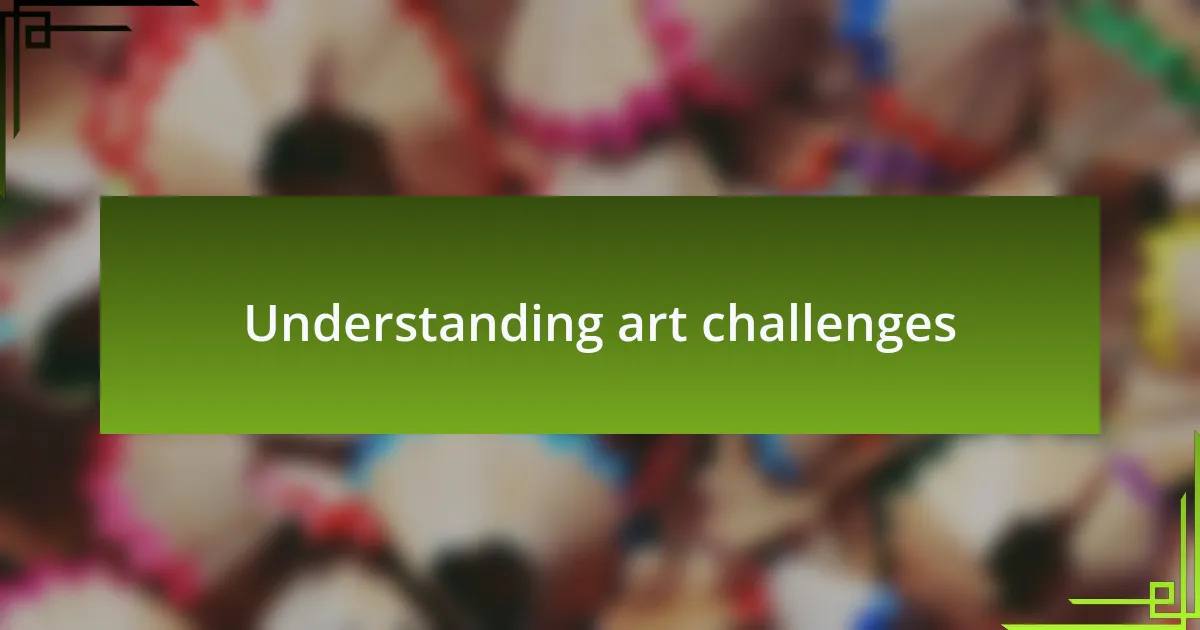
Understanding art challenges
Art challenges can feel both exhilarating and intimidating. Think about your own experiences: have you ever faced a theme that sparked your creativity, yet also made you question your skills? I remember entering a challenge that required a piece based solely on emotions. It pushed me to dig deep, to explore not just colors and shapes but the very essence of what I was feeling.
At the heart of these challenges lies the opportunity to grow as an artist. They often present constraints that can be surprisingly liberating, forcing you to think outside the box. I once took part in a 24-hour challenge where I had to use only black and white materials. The limitations really honed my focus and led me to create something I was proud of. This can make you wonder: can restrictions actually lead to more creativity?
Moreover, understanding the community aspect of art challenges can transform your experience. Engaging with fellow participants adds depth to your journey. I’ve found that sharing my progress and receiving feedback not only motivated me but also built connections that lasted beyond the challenge. Have you ever experienced that sense of camaraderie in a creative setting? It’s a reminder that we’re all navigating this artistic path together.
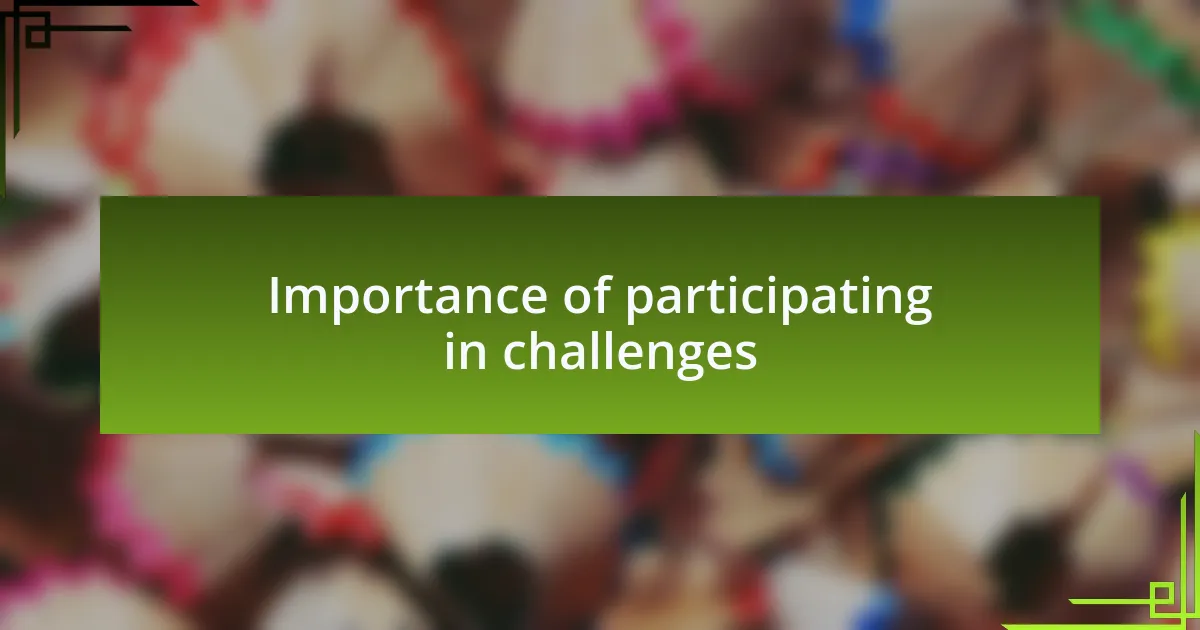
Importance of participating in challenges
Participating in art challenges can be a crucial catalyst for personal growth as an artist. I vividly remember entering a local competition where I had to create a piece within a time constraint. That experience taught me how to work under pressure and sharpened my decision-making skills. How about you? Have you ever discovered new aspects of your artistry when pushed to meet a deadline?
Beyond just skill development, challenges also provide a platform for self-discovery. I once engaged in a themed challenge around cultural heritage, which compelled me to reflect on my roots. This exploration was not only creatively fulfilling but also deeply emotional. What hidden stories might your own work reveal when prompted by such themes?
Moreover, the sense of belonging to a community can amplify your creative journey. During one challenge, I found myself connecting with artists from diverse backgrounds, sharing insights and techniques that enriched my perspective. Isn’t it fascinating how these interactions can elevate not just our work but also our artistic experiences? Embracing these opportunities helps us realize that we’re all part of a larger narrative, each of us contributing our unique voice.

Preparing for art competitions
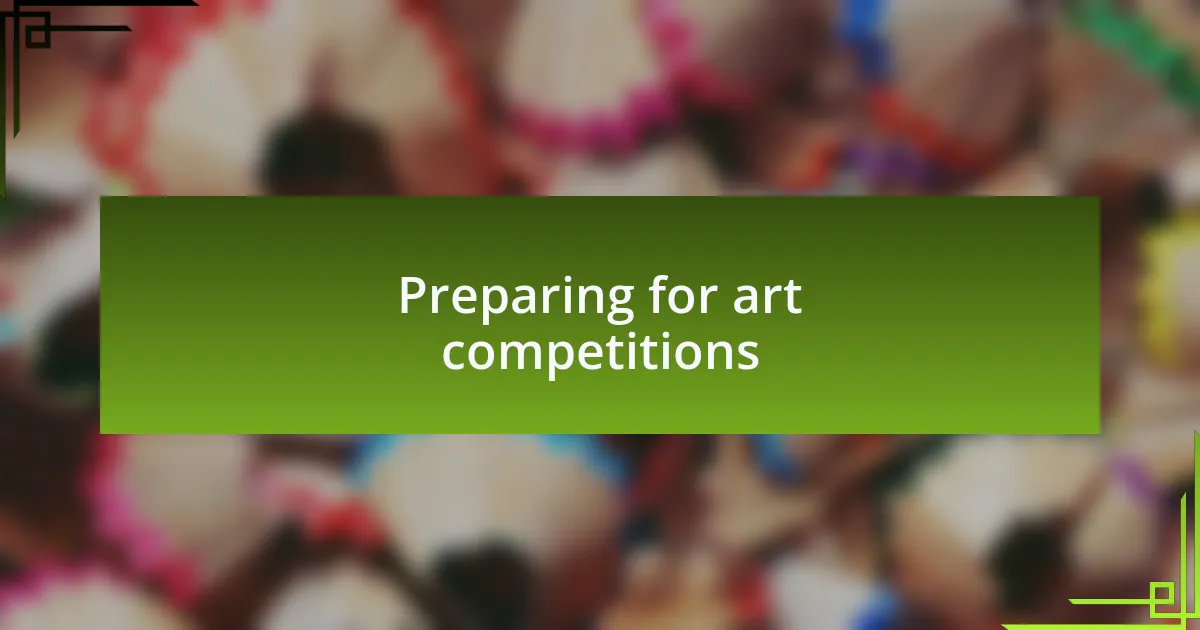
Preparing for art competitions
When gearing up for an art competition, I’d recommend creating a solid plan that outlines your goals and deadlines. I remember the first time I tackled a major competition; I sketched a timeline for each phase of my artwork. This not only kept me organized but also made the creative process feel more manageable. Have you ever felt overwhelmed by a project with no clear steps? I think planning can alleviate that stress.
Researching the competition theme and rules is equally important. I once approached a challenge without fully understanding its criteria, and it taught me a valuable lesson. By aligning my work with the competition’s vision, I can craft pieces that resonate more with the judges. Have you considered how well your artwork fits the guidelines before submitting your work?
Lastly, don’t underestimate the power of practice. When I prepared for my last competition, I dedicated time to experiment with different techniques and materials. This practice not only enhanced my skills but also built my confidence. Are you willing to push your boundaries in preparation? Trust me, those extra hours can make a world of difference on competition day.

Developing your unique style
Finding your unique style is an exciting journey that requires both introspection and experimentation. I recall spending weekends sketching and painting without any particular goal in mind, simply allowing my thoughts and feelings to translate onto the canvas. This free exploration led me to discover color palettes and techniques that truly resonated with my emotions. Have you allowed yourself that kind of creative freedom?
As I began developing my style, I also learned the importance of feedback. I remember sharing a piece with a group of fellow artists, and their perspectives were enlightening. They pointed out elements of my work that were undeniably “me,” things I had overlooked. Have you sought out constructive criticism from others? It can be a game changer in recognizing the aspects of your art that are authentically yours.
Incorporating personal experiences into my work has also played a vital role in shaping my style. For instance, after a deeply moving travel experience, I created a series that captured the essence of those moments. The emotional weight of that journey infused my art with a unique voice. How do your personal stories influence your creations? Embracing your life’s experiences can help define a style that’s distinctively yours.
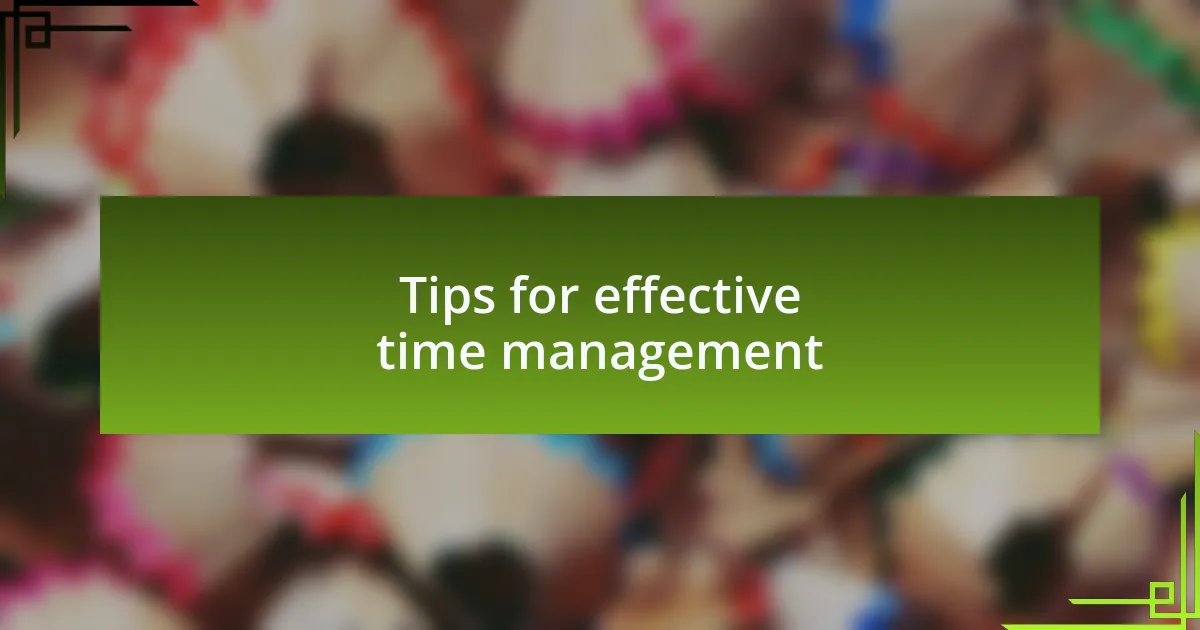
Tips for effective time management
When it comes to managing your time effectively during art challenges, setting clear goals can be a game changer. I’ve found that breaking down my project into smaller, manageable tasks helps me stay focused and motivated. For example, instead of telling myself I need to complete an entire piece, I set goals like finishing the sketch or selecting my colors for the day. Have you tried creating a mini timeline for your projects?
Another strategy I’ve embraced is the power of creating a distraction-free workspace. I remember a time when I was deep into a challenge but constantly found myself sidetracked by my phone or lingering conversations. By setting specific hours for my art and informing others that I’ll be unavailable, I can concentrate on my work without interruptions. Do you create boundaries around your creative time?
Lastly, I suggest using a timer to keep yourself accountable while working. I often employ the Pomodoro Technique, which involves working in focused bursts followed by a short break. This method not only boosts my productivity but also prevents burnout. How do you ensure that you remain energized and engaged throughout the creative process?
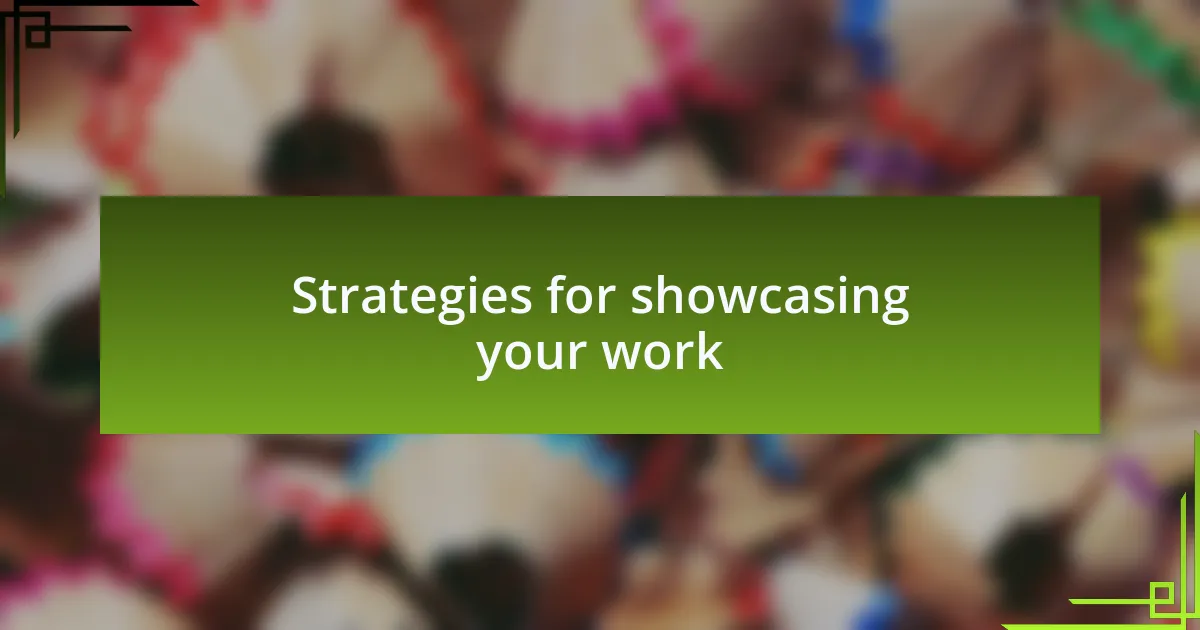
Strategies for showcasing your work
Showcasing your work effectively can significantly enhance your chances of standing out in art challenges. One strategy I’ve found helpful is curating a strong visual portfolio that tells a story. I remember working on a series of paintings where I meticulously arranged them in my portfolio to flow from one theme to another. This approach not only captivated my audience but also made my artistic journey relatable. Have you considered how the order of your pieces can impact their reception?
Another powerful tactic is engaging with your audience through social media. I’ve witnessed firsthand how sharing progress shots, behind-the-scenes clips, and even personal reflections can create a connection with viewers. When I posted a quick video of my painting process, I received an influx of comments and encouragement that motivated me to push forward. What’s your experience with audience interaction?
Lastly, I encourage you to explore the use of creative display methods during exhibitions or contests. I recall a time when I used unconventional materials to frame my artwork, which drew attention and sparked conversations. It made my pieces memorable and gave viewers something to think about long after they left the exhibition. How do you currently choose to present your work to make an impression?
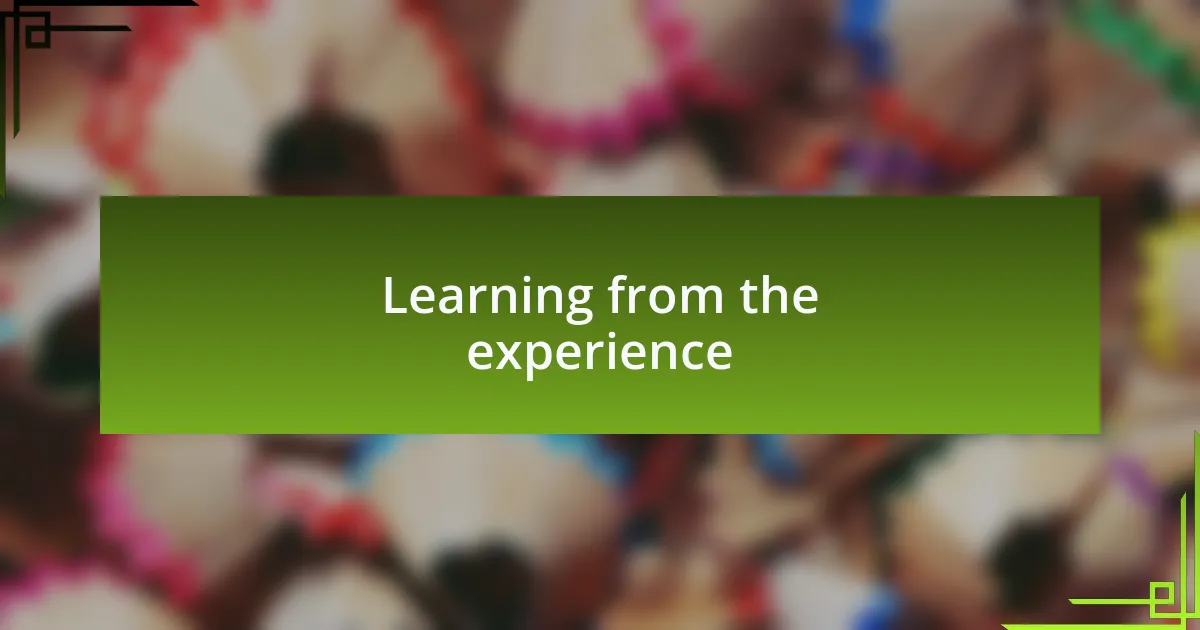
Learning from the experience
Learning from each art challenge I’ve participated in has been a transformative experience. After one particular contest, I looked back and realized the importance of constructive criticism. While it stung a bit to hear some judges weren’t fond of my use of color, that feedback pushed me to explore new palettes in subsequent works. Have you ever found value in feedback that initially felt harsh?
I also learned that every challenge is an opportunity for growth, both artistically and personally. I remember a competition where I was out of my comfort zone, creating a sculpture instead of my usual paintings. The process was exhilarating and intimidating at first, but I discovered a new dimension to my creativity. How often do you step beyond your artistic boundaries to learn something new?
Reflecting on the moments of doubt I faced during these challenges has also been crucial. There was a time when a late-night panic about my unfinished project nearly overwhelmed me. Instead of succumbing to stress, I used that anxiety as fuel to work through the night. It’s moments like these that remind me how resilience can foster artistic breakthroughs. What has your experience taught you about managing artistic pressure?